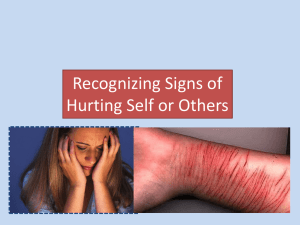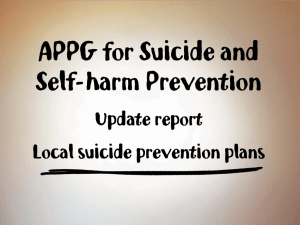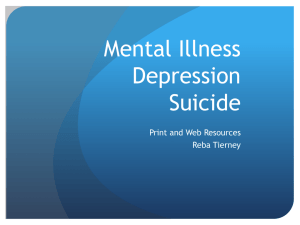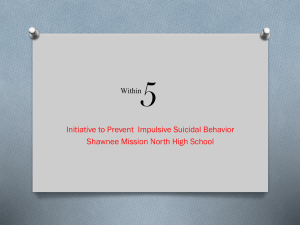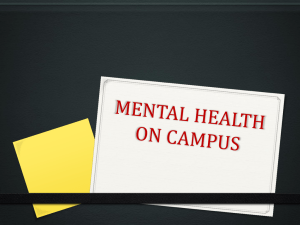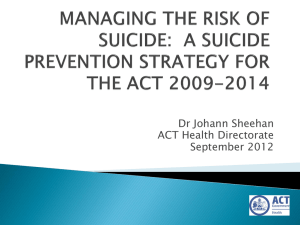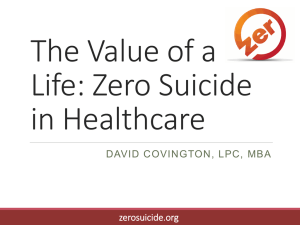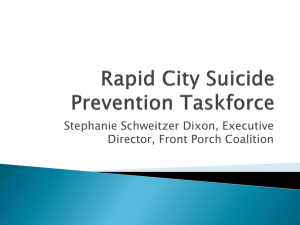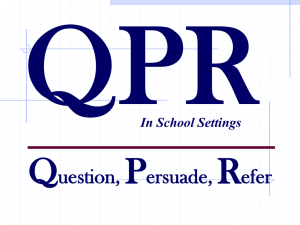More than Sad - American Foundation for Suicide Prevention
advertisement
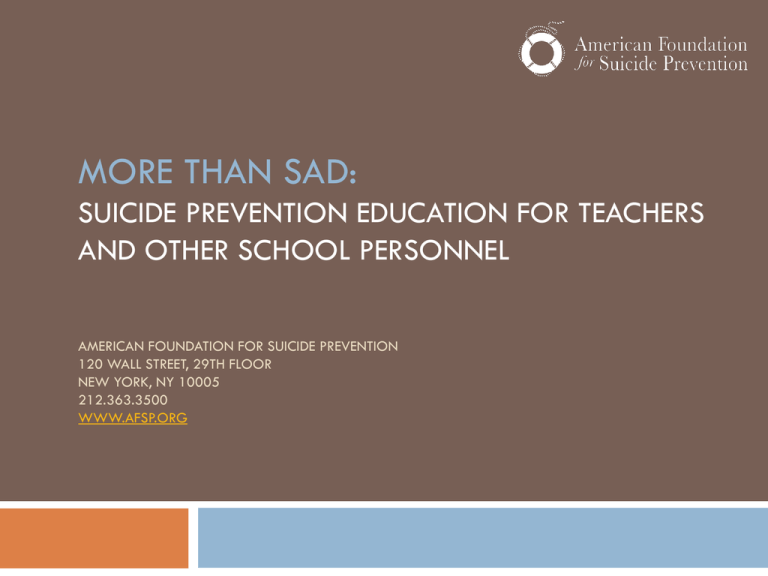
MORE THAN SAD: SUICIDE PREVENTION EDUCATION FOR TEACHERS AND OTHER SCHOOL PERSONNEL AMERICAN FOUNDATION FOR SUICIDE PREVENTION 120 WALL STREET, 29TH FLOOR NEW YORK, NY 10005 212.363.3500 WWW.AFSP.ORG Program Goals 2 1. 2. Increase understanding of: Problem of youth suicide Suicide risk factors Treatment and prevention of suicidal behavior in adolescents Increase knowledge of warning signs of youth suicide so those who work with teens are better prepared to identify and refer at-risk students 3 Understanding the Problem of Suicide Over 40,000 people in the U.S. died by suicide in 2012.1 Suicide Rates: National rate is 12.7 per 100,000 people U.S. rate for youth (ages 15-24) is 11 per 100,000 people based on 2011 data. Suicide is the 2rd leading cause of death for adolescents and young adults (ages 15–24).2 Scope of the Problem (2012*) United States 40,600 reported suicides 12.9 suicides per 100,000 population 31,780 (or 78.3%) of all deaths by suicide are male. 50.9% (20,666) of reported suicides were by firearm US Youth aged 15-24 4,872 reported suicides Suicide is 2rd leading cause of death for youth (after unintentional injuries) *latest year for which suicide statistics are currently available Although the youth you work with as educators are highlighted in the yellow box, the remaining age groups impact the youth as they are the parents, relatives and other caregivers of the 5 youth you serve. U.S. Youth Suicide Rates per 100,000 by Age Group Source: CDC data, 2014 Male youth die by suicide at a rate 4.34x higher than female youth in the U.S. (AAS, 2011) 7 Youth Suicide Rates by Race/Ethnicity (Ages 15-24) Ethnic Group Suicide Rate per 100,000 American Indian/Alaskan Native 19.8 per 100,000 White 12.0 per 100,000 Asian/Pacific Islander 7.6 per 100,000 Black 7.1 per 100,000 Hispanic 7.3 per 100,000 *Number of suicides per 100,000 population, 2012 8 8 Suicide Attempts 9 Attempts are opportunities for us to intervene and save lives! Suicide Attempts 10 No complete or exact count is kept of attempts because of those that go unreported or untreated In 2013, over 180,000 youth between the ages of 10-24 years were hospitalized for self-inflicted injuries. 8 % of high school students reported having attempted suicide one or more times in the last year. Vulnerable Populations 11 Females attempt suicide 3x more often than males Attempts are 2-6x more frequent among youth who identify as gay, lesbian or bisexual, than among heterosexual youth Among young adults ages 15 to 24 years old, there are approximately 100-200 attempts for every death by suicide Based on a 2011 survey of high school students, Hispanic female students (15.6%) reported attempting suicide more times than any other ethnic group. Suicidal Ideation 12 “Ideation” is defined as thinking about or planning for suicide Suicidal Ideation: Based on the 2013 Youth Risk Behavior Survey of High School Students: 13 17% Reported having seriously considered attempting suicide in the previous year. 13.6% Reported having made a plan for a suicide attempt in the previous year. Risk Factors for Teen Suicide 14 Key suicide risk factor for all age groups is an undiagnosed, untreated or ineffectively treated mental disorder 90% of people who die by suicide have a mental disorder In teens, suicide risk is most clearly linked to 7 mental disorders, often with overlapping symptoms: Major Depressive Disorder Conduct Disorder Bipolar Disorder Eating Disorders Generalized Anxiety Disorder Schizophrenia Substance Use Disorders Risk Factors PERPETUATING CONDITIONS PREDISPOSING CONDITIONS PRECIPITATING CONDITIONS (Unchangeable) (of Serious Concern) (Acute) FAMILY Family history of suicide, mental illness, substance abuse Race Gender Genetics Unrealistic parental expectations Abuse (emotional, physical, sexual) Major PERSONAL BEHAVIORAL Loss through death, abandonment, divorce Previous suicide attempt Mental illness Substance abuse Extreme Perfectionism Poor coping/social skills Impulsive Current ENVIRONMENTAL SOCIAL Inconsistent, Experience Active 15 neglectful or abusive parenting Sexual orientation of repeated loss Chronic severe stress Ongoing harassment family conflict Exposure to suicide of family member Anniversary of death Moving often acute Mental Illness Severe stress/anxiety Isolation Rejection Relationship break-up Increased use of substances suicide cluster in community Access to lethal means Bullying, harassment Loss of freedom (e.g., incarceration) 16 Bullying and Suicidal Behavior Among middle-school students, suicidal ideation and behavior are more common in bully-victims and physically aggressive bullies than in verbal bullies and victims who don’t bully others. Intergroup differences largely disappeared after controlling for delinquency and depression (Espelage & Holt, 2013) Among youth who were bullied during high school, suicidal ideation and behavior was later identified only in those who had shown symptoms of depression at the time the bullying occurred (Klomek et al., 2011) 17 What does this mean? Being bullied does not appear to be directly related to suicidal behavior in youth Depression and other underlying factors are central to the development of suicidal behavior Youth who bully others may be significantly more at risk than those who are bullied The repeated message that youth are dying by suicide because they were bullied may well be contributing independently to youth suicide 18 Suicide Warning Signs Suicide risk factors endure over some period of time, while warning signs signal imminent suicide risk Clearest warning signs for suicide are behaviors that indicate the person is thinking about or planning for suicide, or is preoccupied or obsessed with death Looking for ways to kill oneself (e.g., searching the internet for methods, seeking access to firearms or other means for suicide) Talking or writing about suicide Talking or writing about death in a way that suggests preoccupation Watch the Film More Than Sad: Preventing Teen Suicide 20 Facts about Treatment Some depressed teens show improvement in 4-6 weeks with structured psychotherapy alone Most others experience significant reduction of depressive symptoms with antidepressant medication Supplementary interventions – exercise, yoga, breathing exercises, changes in diet – improve mood, relieve anxiety and reduce stress that contributes to depression Medication is usually essential in treating severe depression, and other serious mental disorders (bipolar disorder, schizophrenia, etc.) 21 Summary Points about Treatment No single approach or medication works for all teens with a mental disorder; sometimes different ones needs to be tried But, studies show that 80% of depressed people can be effectively treated Mental disorders can recur, even if effectively treated at one point in time On-going monitoring by a mental health professional is advised 22 Identifying At-Risk Students Most adults are not trained to recognize signs of serious mental disorders in teens Symptoms are often misinterpreted or attributed to Normal adolescent mood swings Laziness Poor attitude Immaturity, etc., etc. … The film, More Than Sad: Teen Depression, is designed for teens but also helps adults understand what depression looks like in adolescents and recognize the warning signs that a teen may need help 23 Watch the Film More Than Sad: Teen Depression Discussion Questions: 24 Which of the four students in the film would you have been most likely to recognize as depressed? Were there any of the students you would not think of as being depressed? What do you think makes it hard for teens to ask for help, even when they want it? 25 Reducing Suicide Risk in Schools So far, we have emphasized two key suicide prevention tasks of school personnel: 1. Identify students whose behavior suggests presence of a mental disorder 2. Take necessary steps to insure that such students are referred to a mental health professional for evaluation and treatment, as needed What else can schools do? 26 Recommended Actions for Schools Educate Students about Mental Disorders Show and discuss film, More Than Sad: Teen Depression with students Use lesson plan in Facilitator’s Guide Include school-based health or mental health professional Educate Parents about Mental Disorders and Suicide Risk Show and discuss film, More Than Sad: Teen Depression at parent meeting Resources for Your School 27 Model School District Policy on Suicide Prevention Collaboration between AFSP, The Trevor Project, the National Association of School Psychologists, and the American School Counselor Association The model provides school districts with recommended language for school district policies that address preventing, assessing the risk of, intervening in, and responding to youth suicidal behavior. Resources for Your School Cont. 28 After a Suicide: A Toolkit for Schools Collaboration between AFSP and the Suicide Prevention Resource Center This toolkit serves as a practical resource for schools facing real-time crises to help them determine what to do, when, and how. Includes existing material and research findings as well as references, templates, and links to additional information and assistance. Accessing Help 24/7 29 1-800-273-TALK www.crisischat.org Online Resources www.afsp.org www.suicideprevetnionlifeline.org www.suicidology.org www.sprc.org www.thetrevorproject.org www.save.org www.cdc.gov www.samhsa.gov www.actionallianceforsuicideprevention.org

